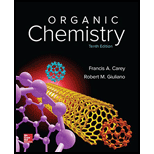
Organic Chemistry - Standalone book
10th Edition
ISBN: 9780073511214
Author: Francis A Carey Dr., Robert M. Giuliano
Publisher: McGraw-Hill Education
expand_more
expand_more
format_list_bulleted
Concept explainers
Textbook Question
Chapter 4.10, Problem 16P
Draw Fischer projections of the four stereoisomeric
Expert Solution & Answer
Want to see the full answer?
Check out a sample textbook solution
Students have asked these similar questions
Compound A boils at 25 C Compound B boils at 80 C Which has the strong IMFs? OB O A
Draw the products formed when cholesterol is treated with each reagent. Indicate the stereochemistry around anystereogenic centers in the product.a. CH3COCIb. H2, Pd-Cc. PCCd. leic acid, H+e. [1] BH3 ·THF; [2] H2O2, -OH
16. Draw the open-chain Fischer projection for the pyranose shown below.
Chapter 4 Solutions
Organic Chemistry - Standalone book
Ch. 4.2 - Examine the following for chirality centers:Ch. 4.2 - Prob. 2PCh. 4.3 - Prob. 3PCh. 4.3 - Prob. 4PCh. 4.4 - Prob. 5PCh. 4.4 - Prob. 6PCh. 4.5 - Does the molecular model shown represent...Ch. 4.6 - Assign absolute configurations as R or S to each...Ch. 4.6 - Draw three-dimensional representations ofCh. 4.7 - Prob. 10P
Ch. 4.7 - Using the Fischer projection of (R)-2-butanol...Ch. 4.8 - Prob. 12PCh. 4.9 - Prob. 13PCh. 4.9 - Prob. 14PCh. 4.10 - Prob. 15PCh. 4.10 - Draw Fischer projections of the four...Ch. 4.10 - Prob. 17PCh. 4.11 - A meso stereoisomer is possible for one of the...Ch. 4.11 - One of the stereoisomers of...Ch. 4.12 - Prob. 20PCh. 4.12 - Prob. 21PCh. 4.13 - Prob. 22PCh. 4.13 - Prob. 23PCh. 4.13 - Prob. 24PCh. 4.14 - Prob. 25PCh. 4 - Prob. 26PCh. 4 - Including stereoisomers, write structural formulas...Ch. 4 - Prob. 28PCh. 4 - Prob. 29PCh. 4 - Prob. 30PCh. 4 - Prob. 31PCh. 4 - Prob. 32PCh. 4 - Prob. 33PCh. 4 - Prob. 34PCh. 4 - Prob. 35PCh. 4 - Prob. 36PCh. 4 - Prob. 37PCh. 4 - Prob. 38PCh. 4 - Prob. 39PCh. 4 - (-)-Menthol is the most stable stereoisomer of...Ch. 4 - Prob. 41PCh. 4 - Prob. 42PCh. 4 - (a) An aqueous solution containing 10 g of...Ch. 4 - Prob. 44DSPCh. 4 - Prob. 45DSPCh. 4 - Consider two chemical changes: one occurring at a...Ch. 4 - Consider two chemical changes: one occurring at a...Ch. 4 - Prob. 48DSPCh. 4 - Consider two chemical changes: one occurring at a...Ch. 4 - Consider two chemical changes: one occurring at a...
Knowledge Booster
Learn more about
Need a deep-dive on the concept behind this application? Look no further. Learn more about this topic, chemistry and related others by exploring similar questions and additional content below.Similar questions
- Draw a Haworth projection for each compound using the structures. α-D-tagatofuranosearrow_forwarda. Draw a three-dimensional structure for the following steroid. b. What is the structure of the single stereoisomer formed by reduction of this ketone wrth H2, Pd-C? Explain why only one stereoisomer is formed.arrow_forwardDraw the structure of Ethyl 2-deoxoy-2-fluoro-a-D-galactopyranoside in: i) cyclized Fischer projection ii) in its most stable chair configuration iii) in its least stable chair confirmationarrow_forward
- Draw the products formed when α-D-galactose is treated with each reagent: i. CH3I (excess), Ag2O ii. CH3OH, H3O+ iii. NaOH, H2O iv. Br2, H2Oarrow_forward1. Show the steps in drawing the alpha pyranose of D-sorbose. 2. Show the steps in drawing the boat conformation of D-sorbose. 3. Show the steps in drawing the chair conformation of D-sorbose.arrow_forwardrank the products in the indicated CH2 groups in order of increasing acidity and give reasons why.arrow_forward
arrow_back_ios
arrow_forward_ios
Recommended textbooks for you

NMR Spectroscopy; Author: Professor Dave Explains;https://www.youtube.com/watch?v=SBir5wUS3Bo;License: Standard YouTube License, CC-BY